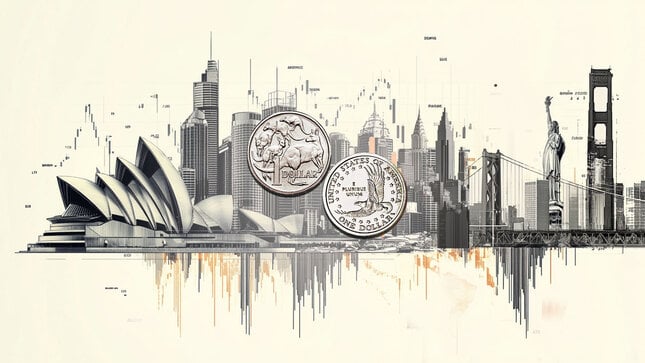There are three factors driving gold bulls as we move into the new year – the demand factor, the Fed factor, and the January factor.
Gold just wrapped up its best year since 2020 with a 13 percent gain, and the yellow metal has new records in its crosshairs as we move into 2024.
Gold faced significant headwinds throughout most of 2023 with dollar strength and a higher interest rate environment. But as the markets began to anticipate an end to the Federal Reserve’s inflation fight, gold rallied during the fourth quarter.
Gold surged to a new record high in early December topping out at just over $2,125 an ounce. It couldn’t sustain those highs, but it has since built strong support at $2,000 an ounce, creating a foundation for gold to test new highs in the coming year.
The demand factor
Saxo Bank's Ole Hansen told Reuters he sees three significant demand factors boosting gold as we move into the new year.
Following on from a surprisingly robust performance in 2023 we see further price gains in 2024, driven by a trifecta of momentum-chasing hedge funds, central banks continuing to buy physical gold at a firm pace, and not least renewed demand from ETF investors.
Looking a little deeper at Hansen's trifecta, we can start with central banks.
Globally, central banks gobbled up gold last year and there is no reason to think their appetite will decrease.
Through the first three quarters of 2023, central banks bought a net of 800 tons of gold. That was 14 percent more than through the same period in 2022, which was a record year dating back to 1950.
There’s no sign that central bank gold buying will abate in the coming year. According to the 2023 Central Bank Gold Reserve Survey released by the World Gold Council last spring, 24 percent of central banks indicated that they planned to add more gold to their reserves in the next 12 months. Seventy-one percent of central banks surveyed believe the overall level of global reserves would increase in the next 12 months. That was a 10-point increase over 2022.
While central bank gold buying was robust, ETF investing was tepid, with metal flowing out of gold-backed ETFs through most of 2023. But outflows slowed significantly in November with North American ETFs charting gold inflows for the first time in five months.
With the price of gold rallying, we will likely see more gold flowing into ETFs in the coming months, boosting overall global gold demand.
As Hansen alluded to, the price rally coupled with the anticipation of a lower interest rate environment could also pull some of the institutional investors back into gold.
Overall, the demand dynamics for gold seem to be on the plus side.
The Fed factor
By far the biggest factor driving the precious metals market is Federal Reserve Monetary policy.
The rally in gold started when the markets began to anticipate the central bank would end its rate hiking and pivot toward rate cuts.
The Fed gave markets exactly what they were looking for at the December FOMC meeting.
The central bank didn’t make any policy moves, but it released its dot plots indicating three rate cuts for 2024 with another four cuts in 2025. That would lower rates to between 2 and 2.5 percent.
The mainstream interprets this as victory over inflation, but it would be more accurate to call it a surrender. By every metric, inflation remains far above the Fed’s 2 percent target. Even Federal Reserve Chairman Jerome Powell admitted price inflation isn’t dead.
Inflation has eased from its highs, and this has come without a significant increase in unemployment. That’s very good news. But inflation is still too high. Ongoing progress in bringing it down is not assured and the path forward is uncertain.
Nevertheless, FOMC members must know that an economy built on borrowing and levered to the hilt can’t survive in a higher interest rate environment. The central bank is easing out of the fight now with its fingers crossed, hoping it has done enough to tame price inflation without crashing the economy.
I call this wishful thinking.
Ironically, financial conditions aren’t all tight, despite the Fed raising rates from zero to 5.5 percent and Powell’s claims that rates are now “well into” restrictive territory.
They aren’t.
The Chicago Fed’s own Financial Conditions Index confirms this. As of the week ending December 22, the index stood at -0.54. A negative number indicates loose financial conditions.
So, while the Fed has tightened conditions enough to break a financial system buried in debt, it is far from tight enough to truly rein in inflation.
Regardless, the bigger problem is that by declaring victory and pivoting to rate cuts, the Fed is returning to the very policies that caused price inflation to begin with.
In other words, a “win” over inflation means more inflation.
But for now, perception is reality, and the perception is everything is fine. The Fed won the inflation fight with no collateral damage to the economy. Now we can go back to the easy money drug the markets crave. There will be no recession. Good times are here again.
I agree that rate cuts are coming. And I think the Fed will have to go back to quantitative easing. But not because it beat inflation. In all likelihood, it will be desperately trying to prop up a crashing economy as the high interest rates finally pop the debt bubbles.
But whether the Fed cuts rates because it thinks it beat inflation or because it is fighting a deep recession, it is equally bullish for gold.
Consider this: gold has fared pretty well this year despite the headwinds, despite the strong dollar, and despite the perception that higher for longer interest rates were bad for gold. If gold did as well as it did in an environment of raising rates and negative perception, imagine how much better it is going to do when rates are falling – especially if they’re falling even as inflation is heating up again.
The January factor
Gold already has plenty of momentum moving into the new year and January is historically a good month for gold.
According to data crunching by the World Gold Council, since 1971, gold has had an average return of 1.79 percent in January. That’s nearly three times the long-term monthly average.
Over that same period, gold has charted positive returns in January almost 60 percent of the time. Going back to 2000, gold has gained during 70 percent of Januaries.
The World Gold Council points to three factors that may boost gold’s January performance.
- Beginning of the year portfolio rebalancing
- Season weakness in real yields
- Gold restocking in East Asia ahead of the Lunar New Year
Past performance does not guarantee future results, and there are exceptions to this general trend. We saw negative returns in January 2021 and 2022.
But as we move into 2024, there appears to be a good setup for gold to have another strong January.
As I’ve already pointed out, Federal Reserve rate hikes are on hold, and most people expect the central bank to start cutting rates this year. This should put a damper on dollar strength. In fact, we could see significant dollar weakness as we move into 2024. This would eliminate a major headwind for gold that persisted through most of 2023.
We also saw renewed strength in the Chinese gold market through the last half of 2023. This could mean an increase in demand as we move into the Chinese New Year.
Taken together, the demand factor, the Fed factor, and the January factor provide three good reasons to be bullish on gold going into the new year.
Money Metals Exchange and its staff do not act as personal investment advisors for any specific individual. Nor do we advocate the purchase or sale of any regulated security listed on any exchange for any specific individual. Readers and customers should be aware that, although our track record is excellent, investment markets have inherent risks and there can be no guarantee of future profits. Likewise, our past performance does not assure the same future. You are responsible for your investment decisions, and they should be made in consultation with your own advisors. By purchasing through Money Metals, you understand our company not responsible for any losses caused by your investment decisions, nor do we have any claim to any market gains you may enjoy. This Website is provided “as is,” and Money Metals disclaims all warranties (express or implied) and any and all responsibility or liability for the accuracy, legality, reliability, or availability of any content on the Website.
Editors’ Picks

When are the China Retail Sales, Industrial Production and how could they affect AUD/USD?
The National Bureau of Statistics of China will publish its data for November at 02.00 GMT. AUD/USD trades on a positive note on the day in the lead up to the China Retail Sales, Industrial Production data. The pair gains ground as US Dollar softens amid the prospect of interest rate cuts by the US Federal Reserve next year.

USD/JPY weakens below 156.00 amid Fed rate cut outlook, BoJ rate hike anticipation
The USD/JPY pair trades on a negative note near 155.75 during the early Asian session on Monday. The US Dollar softens against the Japanese Yen amid the prospect of interest rate cuts by the US Federal Reserve next year.

Gold holds steady above $4,300 amid supportive fundamental backdrop
Gold kicks off the new week on a slightly positive note following Friday's late pullback from levels just above mid-$4,300s or the highest since October 21. Bets for two more rate cuts by the US Fed next year continue to act as a tailwind for the non-yielding bullion. Apart from this, a softer risk tone and geopolitical uncertainties benefit the safe-haven precious metal. However, a modest US Dollar uptick might cap gains ahead of the delayed US NFP report on Tuesday.

Week ahead: US NFP and CPI, BoE, ECB and BoJ mark a busy week
After Fed decision, dollar traders lock gaze on NFP and CPI data. Will the BoE deliver a dovish interest rate cut? ECB expected to reiterate “good place” mantra. Will a BoJ rate hike help the yen recover some of its massive losses?

Big week ends with big doubts
The S&P 500 continued to push higher yesterday as the US 2-year yield wavered around the 3.50% mark following a Federal Reserve (Fed) rate cut earlier this week that was ultimately perceived as not that hawkish after all. The cut is especially boosting the non-tech pockets of the market.
RECOMMENDED LESSONS
Making money in forex is easy if you know how the bankers trade!
I’m often mystified in my educational forex articles why so many traders struggle to make consistent money out of forex trading. The answer has more to do with what they don’t know than what they do know. After working in investment banks for 20 years many of which were as a Chief trader its second knowledge how to extract cash out of the market.
5 Forex News Events You Need To Know
In the fast moving world of currency markets where huge moves can seemingly come from nowhere, it is extremely important for new traders to learn about the various economic indicators and forex news events and releases that shape the markets. Indeed, quickly getting a handle on which data to look out for, what it means, and how to trade it can see new traders quickly become far more profitable and sets up the road to long term success.
Top 10 Chart Patterns Every Trader Should Know
Chart patterns are one of the most effective trading tools for a trader. They are pure price-action, and form on the basis of underlying buying and selling pressure. Chart patterns have a proven track-record, and traders use them to identify continuation or reversal signals, to open positions and identify price targets.
7 Ways to Avoid Forex Scams
The forex industry is recently seeing more and more scams. Here are 7 ways to avoid losing your money in such scams: Forex scams are becoming frequent. Michael Greenberg reports on luxurious expenses, including a submarine bought from the money taken from forex traders. Here’s another report of a forex fraud. So, how can we avoid falling in such forex scams?
What Are the 10 Fatal Mistakes Traders Make
Trading is exciting. Trading is hard. Trading is extremely hard. Some say that it takes more than 10,000 hours to master. Others believe that trading is the way to quick riches. They might be both wrong. What is important to know that no matter how experienced you are, mistakes will be part of the trading process.
The challenge: Timing the market and trader psychology
Successful trading often comes down to timing – entering and exiting trades at the right moments. Yet timing the market is notoriously difficult, largely because human psychology can derail even the best plans. Two powerful emotions in particular – fear and greed – tend to drive trading decisions off course.

